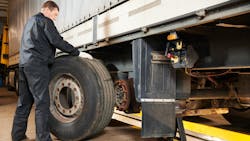For years, I have been using the term “wheel-off” to describe an instance where one or more of the wheels are detached from the vehicle. It’s been a catch-all term, but it definitely implies that the wheels came off, so whoever installed them probably did something wrong. Truck tire and fleet technicians end up with the majority of the blame because they install millions of wheels a year—and someone has to be at fault.
It must be pointed out that millions of wheels and rims are safely installed on commercial motor vehicles on an annual basis. Trillions of miles are traveled on those vehicles without any incidents related to wheel assemblies that somehow get loose. The industry has done an admirable job of educating truck tire service providers and fleets on the proper procedures for installing single and dual wheels. Wheel-off accidents are few and far between from a statistical perspective, but when it happens, it tends to get attention.
February 2021—The left front wheel on a pickup truck crosses the median and strikes an oncoming pickup in Texas. The driver was killed instantly while her 19-year-old son, who was sleeping in the passenger seat, suffered a hand injury.
April 2021—The left front dual wheels and drum are detached from the axle on I-10 in California and cross the median to strike an oncoming vehicle. The occupants were treated for serious injuries but are expected to survive. Their vehicle looks like something out of a superhero movie where the middle of the SUV is crushed like a soda can.
May 2021—Dual wheels with the drum are detached from a tractor-trailer and cross the median to strike an oncoming pickup truck in Massachusetts. The passenger suffered a broken leg.
May 2021—A single tire and wheel is rolling with traffic in Indiana and hits a vehicle. In another scene out of a movie, this time on video, an SUV drives over the top of the tire and flips over twice before landing with the tires on the ground and the roof smashed. The driver was not seriously injured.
It took me less than an hour to find these four accidents. The media coverage included local television news and in one case an interview with the driver. Each of them demonstrate how destructive a loose tire and wheel can be when it strikes another vehicle. It’s not the first time I’ve searched for these types of accidents, but it was the first time that I noticed two of these incidents were not wheel-offs.
A wheel-off is exactly that. The wheel or wheels come off the vehicle and then go their separate ways. The pickup truck and single tire and wheel accidents were definitely wheel-offs. Somehow, the tire and wheel got loose and caused an accident. However, the accidents in California and Massachusetts were not wheel-offs. The wheels never left the axle end. They were still attached to the drum in both instances. It’s a miracle that anyone survived the accident in California. After viewing the photos online, it literally looks like a tree fell down the center of the car and almost split it half lengthwise. Since the duals were still together with the drum, the damage should have been much worse.
In Massachusetts, the driver saw the dual wheels coming and just hung on to the steering wheel. He ended up hitting a tree after hitting the duals and obviously wasn’t injured because he did the interview. His son snapped a picture of him in the hospital bed with a broken leg.
Four accidents in four months in four different parts of the country. It can happen anywhere, at any time, on any vehicle and when it does, there will probably be media coverage. More importantly, there’s a good chance someone could be hurt or killed when they strike a loose wheel or wheel-end assembly.
While in no way can this be considered a trend, the two wheel end detachments deserve some attention. In both cases, the drum separated from the spindle with the wheels still attached. Without any details, it’s unfair to speculate on the causes, but there are steps that fleets can take to prevent these types of accidents.
It starts with pre-trip and post-trip inspections. A vehicle should be placed out of service if there are any oil leaks or signs of an oil leak. Unfortunately, I’ve seen too many vehicles on the road at truck stops, loading docks, and trailer yards that have wheel ends with small leaks. If the hubcap has a sight glass, then it should be visible and not painted over or covered in dirt. It’s important to remember that oil is critical in a spindle hub, so any signs of leaks or low oil must be immediately investigated. Proper bearing maintenance and adjustment are additional steps that fleets can take to prevent wheel end detachments on spindle axles, especially after working on the brakes with inboard drums.
Finally, following the proper installation procedures, including maintaining the correct fastener torque, have also been shown to prevent instances where the wheels are separated from the axle regardless of what you call it.
This article originally appeared on FleetOwner.com.
About the Author

Kevin Rohlwing
Senior Vice President of Training
Kevin Rohlwing is the Senior Vice President of Training for the Tire Industry Association (TIA). He started in the tire business more than 32 years ago as a technician in his family’s dealership in Elgin, Illinois, where he also worked as a salesman and service manager.
In 1996, he joined the International Tire and Rubber Association (ITRA), the predecessor of TIA, as the Director of Commercial Tire Service. Kevin created and produced the Association’s training and certification programs that have educated more than 90,000 technicians since 1997.
In 2011, he was awarded the Silver Spark Plug for excellence in fleet maintenance from the Technology and Maintenance Council of the American Trucking Assns.
